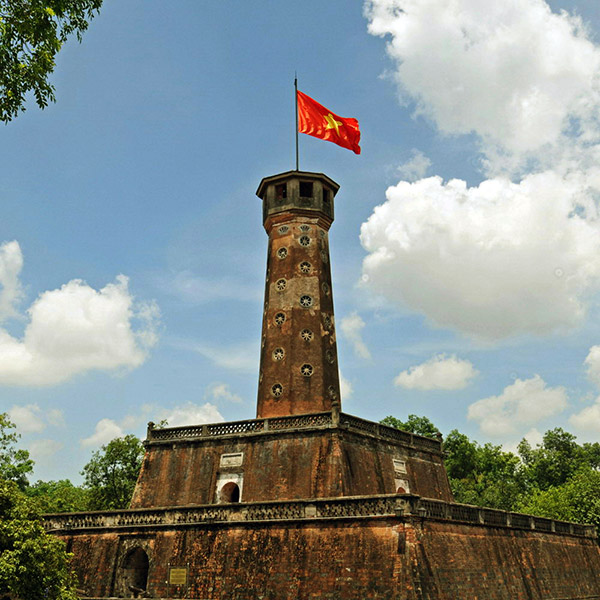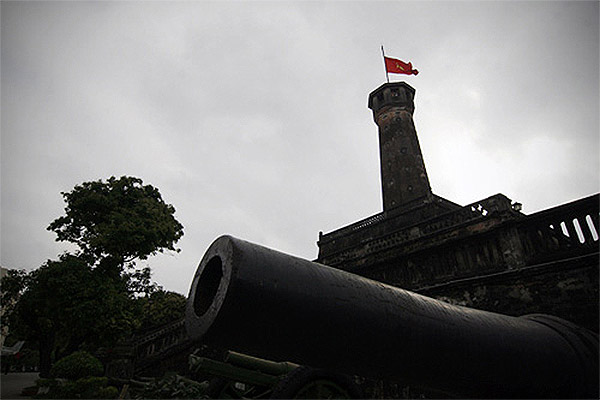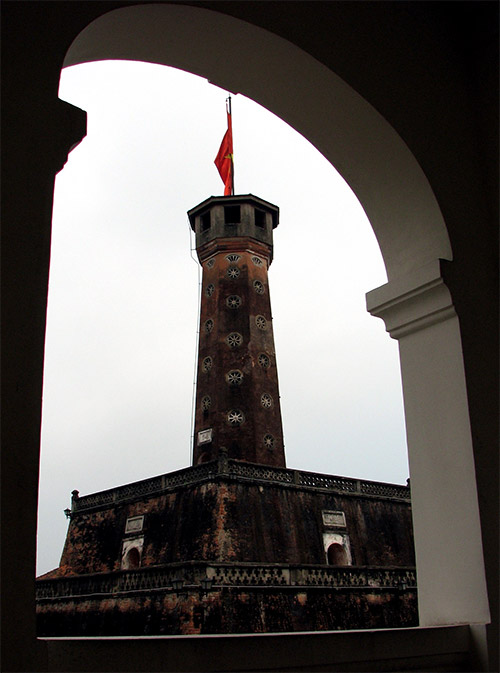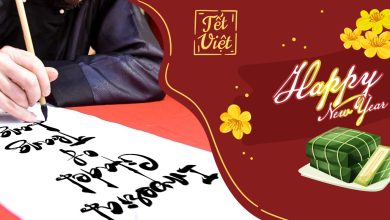Hanoi Flag Tower
Hanoi Flag Tower is situated in Dien Bien Phu Street, Ba Dinh District, Hanoi which was built in 1812 under King Gia Long’s reign, Nguyen Dynasty in the sounthern part of Thang Long Imperial Citadel where Tam Mon Palace under Le Dynasty had been built. This tower marked the beginning point of the southerly central axis, followed by Doan Mon Gate and Kinh Thien Palace – the central and most important point. Hanoi Flag Tower remains an undamaged and the most imposing structure in the entire Thang Long Imperial Vestige.
The Flag Tower includes three-tier basement and a column three storeys and a tower. The truncated square pyramid-shaped storeys are faced with bricks. The first tier has the length of each side of 42.5m, the height of 3.1m and two brick staircases. The second tier has the length of each side of 27m, the height of 3.7m with 4 doors facing four directions. Except the North one, the other three are inscribed with two characters relevant to its direction: East door – Nghênh Húc (To welcome dawn’s sunlight), South door – Hướng Minh (Directed to the sunlight), West door – Hồi Quang (To reflect light). The third tier is a square of 12.5m each side and 5.1m high. There is a spiral staircase leading from the first to the third tier.
The part above the third tier is a column with 8 fringes narrower to the top. Each fringe is 2.13m wide and 18.2m high. The spiral staircase consists of 54 steps. It is lightened and ventilated by 39 flower-shaped and 6 fan-shaped windows which scatter along the fringes with 5 or 6 on each.
On top of the tower is an octagonal observatory of 3.3m high with 8 doors in 8 sides. In the middle of it, there is a round base of 0.4 meter in diameter and 8m high up to the top where the national flag is fixed. The whole architecture is 33.4m high from its basement up to the top including three tiers of 12m, column of 18.2m and observatory of 3.3m. If including the round base for flagging on top, the structure is 41.4m high.
Hanoi Flag Tower is one of the rare architectural works in Hanoi Citadel that was fortunate enough to not be destroyed by the French domination administration between 1894 and 1897.
On October 10th, 1954, the red flag with yellow star, the National Flag, flied on the top of Hanoi Flag Tower for the first time which was recognized as the historical monument in 1989. That day, the people jubilantly welcomed the Festival of Victory, the day Hanoi became completely liberated. The people marched towards Hanoi Flag Tower, waiting for a historic moment: the hoisting ceremony of National Flag on the top of Hanoi Flag Tower.
At 3pm on October 10th, 1954, the siren of Hanoi Opera House wailed for a while. And then, while the military band was playing the national anthem under the direction of Comrade Dinh Ngoc Lien, the National Flag was gradually hoisted. For the first time, the red flag with yellow star, the National Flag, flied on the top of Hanoi Flag Tower. Until now, Hanoi Flag Tower is nearly 200 years old. When Democratic Republic of Vietnam was born, the image of Hanoi Flag Tower was solemnly printed on the first coins of Vietnam State Bank.
For more than half of a century, plugged on the top of Hanoi Flag Tower, the red flag with yellow star has flied in the sky of Thang Long – Hanoi Capital of thousand years tradition as a symbol of glory and pride of an independence and freedom Vietnam. According to study documents, since 1986, a 24m2 red flag with yellow star has always streamed over Hanoi Flag Tower.
Nowadays, Hanoi Flag Tower is situated by Dien Bien Phu Street with ancient nacre trees a luxuriant garden of longan trees.
According to some researches, in a photo taken in 1890 by Louis Sadoul, a French army medical officer, the current Lenin Park near to Hanoi Flag Tower had the name of Elephant Lake because this was the place for bathing elephants under Nguyen Dynastry. The current ancient trees still had not been grown. We can also see in the photo that French army set up relatively firm camps on the storeys of the Tower.
Additioanlly, during this time, Hanoi Flag Tower was used as an observation tower by French Army. In American war, it was also an observation tower of Hanoi’s air defence forces. At that time, from the top of the tower, it was possible to observe the whole Hanoi and the suburb.
A special thing is that during the hottest days in Hanoi, the atmosphere inside the Tower is always cool. The structure of doors is so scientific that the rainwater can not flow into the Tower however heavy the rain is.








